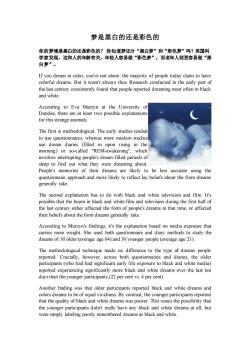《新编大学英语》综合教程(第三版第二册)B2U5_Self-market_Reading Material_梦是黑白的还是彩色的

梦是黑白的还是彩色的 你的梦境是黑白的还是彩色的?你知道梦还分“黑白梦”和“彩色梦”吗?英国科 学家发现,这和人的年龄有关,年轻人容易做“彩色梦”,而老年人则更容易做“黑 白梦”。 If you dream in color,you're not alone:the majority of people today claim to have colorful dreams.But it wasn't always thus.Research conducted in the early part of the last century consistently found that people reported dreaming most often in black and white According to Eva Murzyn at the University Dundee,there are at least two possible explanations for this strange anomaly. The first is methodological.The early studies tended to use questionnaires,whereas more modern studies use dream diaries (filled in upon rising in the morning)or so-called "REM-awakening",which involves interrupting people's dream-filled periods of sleep to find out what they were dreaming about. People's memories of their dreams are likely to be less accurate using the questionnaire approach and more likely to reflect lay beliefs about the form dreams generally take. The second explanation has to do with black and white television and film.It's possible that the boom in black and white film and television during the first half of the last century either affected the form of people's dreams at that time,or affected their beliefs about the form dreams generally take. According to Murzyn's findings,it's the explanation based on media exposure that carries more weight.She used both questionnaire and diary methods to study the dreams of 30 older(average age 64)and 30 younger people (average age 21). The methodological technique made no difference to the type of dreams people reported.Crucially,however,across both questionnaires and diaries,the older participants (who had had significant early life exposure to black and white media) reported experiencing significantly more black and white dreams over the last ten days than the younger participants(22 per cent vs.4 per cent). Another finding was that older participants reported black and white dreams and colors dreams to be of equal vividness.By contrast,the younger participants reported that the quality of black and white dreams was poorer.This raises the possibility that the younger participants didn't really have any black and white dreams at all,but were simply labeling poorly remembered dreams as black and white
梦是黑白的还是彩色的 你的梦境是黑白的还是彩色的? 你知道梦还分“黑白梦”和“彩色梦”吗?英国科 学家发现,这和人的年龄有关,年轻人容易做“彩色梦”,而老年人则更容易做“黑 白梦”。 If you dream in color, you're not alone: the majority of people today claim to have colorful dreams. But it wasn't always thus. Research conducted in the early part of the last century consistently found that people reported dreaming most often in black and white. According to Eva Murzyn at the University of Dundee, there are at least two possible explanations for this strange anomaly. The first is methodological. The early studies tended to use questionnaires, whereas more modern studies use dream diaries (filled in upon rising in the morning) or so-called "REM-awakening", which involves interrupting people's dream-filled periods of sleep to find out what they were dreaming about. People's memories of their dreams are likely to be less accurate using the questionnaire approach and more likely to reflect lay beliefs about the form dreams generally take. The second explanation has to do with black and white television and film. It's possible that the boom in black and white film and television during the first half of the last century either affected the form of people's dreams at that time, or affected their beliefs about the form dreams generally take. According to Murzyn's findings, it's the explanation based on media exposure that carries more weight. She used both questionnaire and diary methods to study the dreams of 30 older (average age 64) and 30 younger people (average age 21). The methodological technique made no difference to the type of dreams people reported. Crucially, however, across both questionnaires and diaries, the older participants (who had had significant early life exposure to black and white media) reported experiencing significantly more black and white dreams over the last ten days than the younger participants (22 per cent vs. 4 per cent). Another finding was that older participants reported black and white dreams and colors dreams to be of equal vividness. By contrast, the younger participants reported that the quality of black and white dreams was poorer. This raises the possibility that the younger participants didn't really have any black and white dreams at all, but were simply labeling poorly remembered dreams as black and white
按次数下载不扣除下载券;
注册用户24小时内重复下载只扣除一次;
顺序:VIP每日次数-->可用次数-->下载券;
- 《新编大学英语》综合教程(第三版第二册)B2U5_Self-market_Reading Material_关于梦境:十个你可能不知道的真相.docx
- 《新编大学英语》综合教程(第三版第二册)B2U5_Self-market_Reading Material_Meanings in Dreams.docx
- 《新编大学英语》综合教程(第三版第二册)B2U5_Self-market_Listening Material_Transcript.docx
- 《新编大学英语》综合教程(第三版第二册)B2U5_Self-market_06 B2U05 QUIZ.doc
- 《新编大学英语》综合教程(第三版第二册)B2U5 Translation & Writing.ppt
- 《新编大学英语》综合教程(第三版第二册)B2U5 Read by critical thinking.ppt
- 《新编大学英语》综合教程(第三版第二册)B2U5 Menu.ppt
- 《新编大学英语》综合教程(第三版第二册)B2U5 Activate.ppt
- 《新编大学英语》综合教程(第三版第二册)B2U4_Spellbound.docx
- 《新编大学英语》综合教程(第三版第二册)B2U4_Self-market_Writing Material_推展段落方法之——举例法.docx
- 《新编大学英语》综合教程(第三版第二册)B2U4_Self-market_Samples.docx
- 《新编大学英语》综合教程(第三版第二册)B2U4_Self-market_Reading Material_The Psychology of Money.doc
- 《新编大学英语》综合教程(第三版第二册)B2U4_Self-market_Reading Material_Marriage Wards off Blues.doc
- 《新编大学英语》综合教程(第三版第二册)B2U4_Self-market_Reading Material_Leisure Guilt.docx
- 《新编大学英语》综合教程(第三版第二册)B2U4_Self-market_Reading Material_Desk Psychology.doc
- 《新编大学英语》综合教程(第三版第二册)B2U4_Self-market_Listening Material_Transcript.docx
- 《新编大学英语》综合教程(第三版第二册)B2U4_Self-market_06 B2U04 QUIZ.doc
- 《新编大学英语》综合教程(第三版第二册)B2U4 Translation & Writing.ppt
- 《新编大学英语》综合教程(第三版第二册)B2U4 Read by critical thinking.ppt
- 《新编大学英语》综合教程(第三版第二册)B2U4 Menu.ppt
- 《新编大学英语》综合教程(第三版第二册)B2U5_Self-market_Reading Material_盲人的梦境里有画面吗.docx
- 《新编大学英语》综合教程(第三版第二册)B2U5_Self-market_Sample.docx
- 《新编大学英语》综合教程(第三版第二册)B2U5_Self-market_Writing Material_推展段落方法之——叙述法.docx
- 《新编大学英语》综合教程(第三版第二册)B2U6 Activate.ppt
- 《新编大学英语》综合教程(第三版第二册)B2U6 Menu.ppt
- 《新编大学英语》综合教程(第三版第二册)B2U6 Read by critical thinking.ppt
- 《新编大学英语》综合教程(第三版第二册)B2U6 Translation & Writing.ppt
- 《新编大学英语》综合教程(第三版第二册)B2U6_Self-market_06 B2U06 QUIZ.doc
- 《新编大学英语》综合教程(第三版第二册)B2U6_Self-market_Listening Material_Transcript.docx
- 《新编大学英语》综合教程(第三版第二册)B2U6_Self-market_Reading Material_Food and Mood.docx
- 《新编大学英语》综合教程(第三版第二册)B2U6_Self-market_Reading Material_Is chocolate really good for me.docx
- 《新编大学英语》综合教程(第三版第二册)B2U6_Self-market_Reading Material_每天吃相同的食物会影响健康吗.docx
- 《新编大学英语》综合教程(第三版第二册)B2U6_Self-market_Samples.docx
- 《新编大学英语》综合教程(第三版第二册)B2U6_Self-market_Writing Material_推展段落方法之——比较与对比法.docx
- 《新编大学英语》综合教程(第三版第二册)B2U6_料理鼠王transcript.docx
- 《新编大学英语》综合教程(第三版第二册)B2U4_Self-market_06 B2U04 QUIZ_B2U4 Oral Quiz.ppt
- 《新编大学英语》综合教程(第三版第二册)B2U3_Self-market_B2U03 QUIZ_06 B2U3 Quiz.doc
- 《新编大学英语》综合教程(第三版第二册)B2U3_Self-market_B2U03 QUIZ_B2U3 Oral Quiz.ppt
- 《新编大学英语》综合教程(第三版第二册)B2U5_Self-market_B2U05 QUIZ_B2U5 Oral Quiz.ppt
- 《新编大学英语》综合教程(第三版第二册)B2U6_Self-market_B2U06 QUIZ_B2U6 Oral Quiz.ppt
